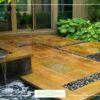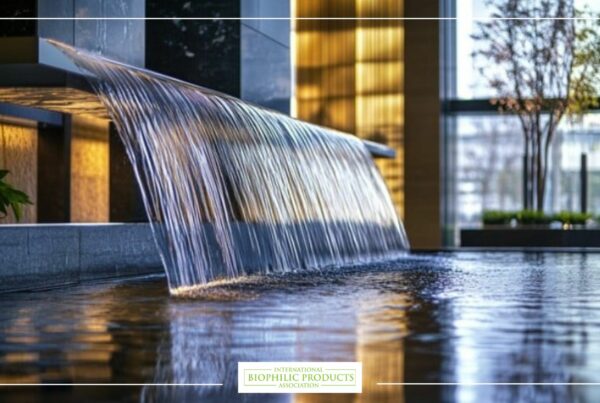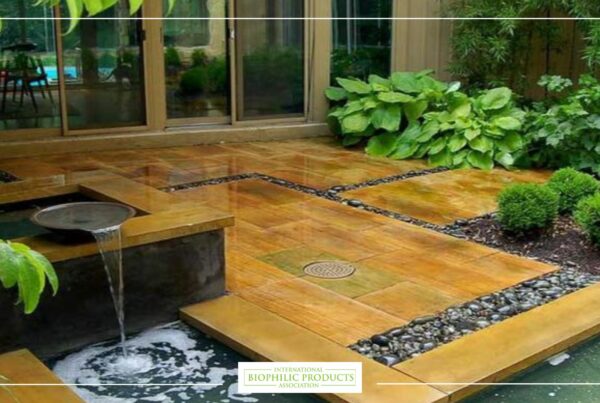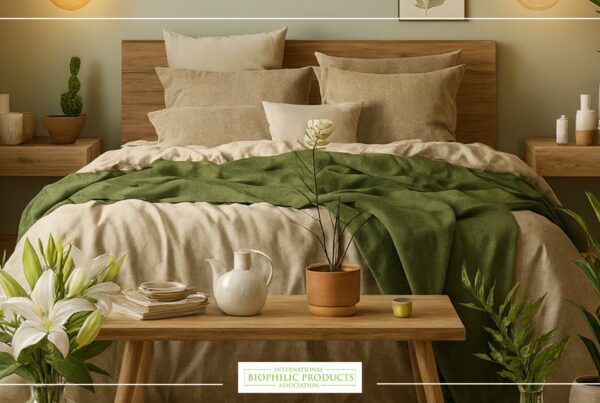Biophilic design is more than just a style; it’s a philosophy grounded in our deep biological connection with nature. But what exactly defines a truly biophilic building? The answer lies in a holistic approach based on three core principles: nature in the space, nature of the space, and natural analogues. When these three pillars come together in harmony, they create environments that are not only functional and beautiful but also nurturing for the human spirit.
The 3 pillars of biophilic architecture
Biophilic design isn’t just about adding plants to a room. It’s about creating spaces that tap into our evolutionary need to connect with the natural world. These three foundational elements work together to shape environments that improve well-being, boost creativity, and enhance.
Nature in the space: real sunlight, plants, fresh air
This first principle focuses on direct physical contact with nature. Think living walls, large windows that let in natural light, interior gardens, and open-air ventilation systems. These aren’t just design trends; they’re powerful tools to positively influence mood and health.
- Sunlight: exposure to daylight regulates our circadian rhythms, improves sleep quality, and enhances concentration.
- Plants: greenery lowers stress, improves air quality, and even increases productivity. In fact, workplaces with natural elements like plants and sunlight report 15% higher levels of well-being and creativity.
- Fresh air: operable windows, cross-ventilation, and natural breezeways do more than cool a space; they support respiratory health and bring the outside in.
This principle is the most visible and instantly felt. It’s what people often associate first with biophilic design.
Nature of the space: mystery, complexity, prospect and refuge
The second pillar is more subtle, yet equally essential. It’s about how a space feels, drawing from the patterns and experiences we evolved to find comforting in the natural world.
- Prospect: open views, long sightlines, and elevated spaces give a sense of orientation and safety—just like standing on a hill watching for danger or opportunity.
- Refuge: small, enclosed areas offer a sense of protection, ideal for resting or focused work.
- Mystery and complexity: winding paths, filtered light, textured surfaces, and layered environments awaken curiosity and engagement.
When you step into a building and feel simultaneously safe, intrigued, and comforted, you’re likely experiencing the nature of the space. These sensory cues activate deep-seated responses in our brain, calming the nervous system and encouraging exploration, according to the study: The Global Impact of Biophilic Design in the Workplace.
Natural analogues: biomorphic patterns, textures, and materials
This principle involves incorporating indirect references to nature into design elements, using materials, patterns, and shapes that mimic or evoke the natural world.
- Biomorphic forms: Curved lines that resemble leaves, vines, or waves can soften the harshness of modern structures.
- Natural textures and materials: Think wood, stone, wool, clay, and linen—materials that age gracefully and tell a story through touch and time.
- Nature-inspired colors: Shades of green, brown, and blue are especially effective in supporting focus and calmness, as shown in several global workplace studies.
These elements connect people to nature even in spaces where direct contact may be limited, such as underground transit systems or inner-city buildings.
Spaces that integrate all three: a new standard in biophilic design
When a space incorporates all three principles, it becomes more than just beautiful, it becomes therapeutic.
Studies show that such environments significantly improve physical and mental health:
- 6% increase in productivity
- 15% boost in creativity
- Up to 15% higher levels of reported well-being.
These spaces also support sustainable living by reducing energy use (natural light and ventilation), filtering air and water (via vegetation), and promoting biodiversity (by attracting local fauna). Projects like the Bosco Verticale in Milan or Fallingwater by Frank Lloyd Wright are iconic examples of buildings that fully embrace the triad of biophilic principles.
Why this matters now more than ever
With nearly 70% of the world’s population expected to live in cities by 2050, our built environments are becoming our primary ecosystems…. But concrete and steel don’t nourish the human soul; nature does.
As the global shift toward wellness real estate and green infrastructure accelerates, biophilic design will no longer be optional. It will be the baseline for resilient, inclusive, and inspiring spaces; from office buildings and schools to homes and hospitals.
Biophilia isn’t a style. It’s a design ethos rooted in who we are.
Designing for the human experience
True biophilic architecture doesn’t just look natural; it feels alive. It breathes, evolves, and responds to its inhabitants. Whether you’re an architect, designer, or simply someone seeking harmony in your space, remember: a building becomes biophilic when it prioritizes people’s connection to nature in every detail.
Want to create spaces that help people thrive? Start with these three questions:
- Is there real nature in the space?
- Does the layout and form make people feel safe, curious, and engaged?
- Are there natural cues in the materials, patterns, or colors?
If the answer is yes to all three, then you’re not just designing a building. You’re designing an experience; and a better future. Join the biophilic design movement.











13 Comments